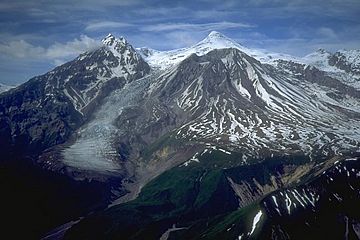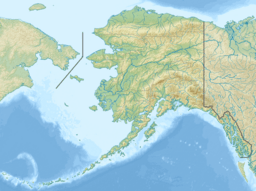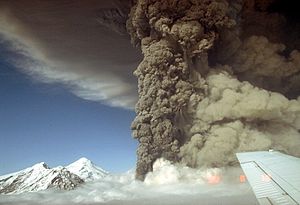Mount Spurr facts for kids
Quick facts for kids Mount Spurr |
|
|---|---|

Mount Spurr from the south
|
|
| Highest point | |
| Elevation | 11,070 ft (3,374 m) |
| Prominence | 585 m (1,919 ft) |
| Parent peak | Mount Torbert |
| Geography | |
| Parent range | Tordrillo Mountains, Alaska Range |
| Topo map | USGS Tyonek B-7 |
| Geology | |
| Age of rock | < 10,000 years |
| Mountain type | Stratovolcano |
| Volcanic arc/belt | Aleutian Arc |
| Last eruption | June to September 1992 |
| Climbing | |
| First ascent | 1960 |
Mount Spurr is a large stratovolcano in Alaska, USA. It is part of a chain of volcanoes called the Aleutian Arc. The mountain is named after Josiah Edward Spurr, a geologist who explored the area in 1898.
The local Dena'ina Athabascan people call the mountain K'idazq'eni. This name means 'that which is burning inside'. The Alaska Volcano Observatory (AVO) watches Mount Spurr closely. They currently rate it as "Green," meaning it is not showing signs of unrest.
About Mount Spurr
Mount Spurr is the tallest volcano in the Aleutian Arc. It is a large, cone-shaped volcano built up by many layers of hardened lava and ash. At its top, there is a big, bowl-shaped area called a caldera. This caldera is about 5 kilometers (3 miles) wide and looks like a horseshoe.
This caldera formed a long time ago. A huge landslide and fast-moving hot ash destroyed an older volcano. The landslide traveled over 25 kilometers (15.5 miles) away! Inside this caldera, new peaks have grown, and Mount Spurr is the highest of them.
Mount Spurr is located about 130 kilometers (80 miles) west of Anchorage, a major city in Alaska. The top of Mount Spurr had a heating event in 2004. This created a small crater lake in the ice and snow. By 2008, the summit had cooled down, and snow started to build up again.
Crater Peak
The youngest part of the volcano is called Crater Peak. It is about 3.2 kilometers (2 miles) south of Mount Spurr. Crater Peak has been the source of about 40 ash layers found from past eruptions.
Mount Spurr's two most recent eruptions happened from Crater Peak. These were in 1953 and 1992. Both eruptions sent ash falling on the city of Anchorage. Crater Peak has its own small crater at its top. Before the 1992 eruption, a small lake was inside this crater.
Why Volcanoes Matter for Air Travel
Like other volcanoes in Alaska, Mount Spurr is close to major flight paths. These are routes that planes take across the Pacific Ocean. When a volcano erupts, the ash it sends into the air can be very dangerous for airplanes. Volcanic ash can cause jet engines to fail. This means an eruption can stop many flights and disrupt air travel.
Recent Activity
On July 26, 2004, the Alaska Volcano Observatory (AVO) changed Mount Spurr's alert level. They raised it from green to yellow. This was because there were more earthquakes happening under the volcano.
Earthquakes under a volcano can mean that magma (molten rock) is moving underground. This movement can sometimes lead to a volcanic eruption. However, sometimes the earthquakes stop, and no eruption happens.
In early August 2004, the AVO reported something new at the summit. A hole had formed in the ice and snow, and it was filled with water. This created a new crater lake. Scientists thought this lake might have formed because more heat was coming from inside the volcano.
On May 3, 2005, a mudslide was seen on webcams and by a pilot flying nearby. Later, a flight over the area showed that much of the water in the melt hole had drained away.
See also
 In Spanish: Monte Spurr para niños
In Spanish: Monte Spurr para niños



